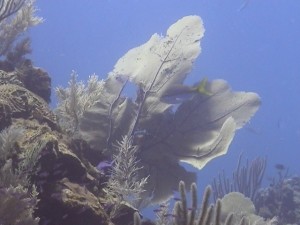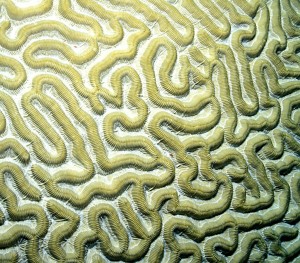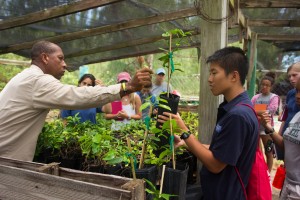Tag Archives: marine ecology
Summer Term 2013 Marine Ecology Class
Summer Term 2013: Student Update July 18, 2013
To be intimate with the land, to have a sense of place, is to enclose it in the same moral universe we occupy, to include it in the meaning of the word community. In Marine Ecology class, summer students do just that, but underwater! Through detailed observation and inquiry, students foster a deeper understanding of how tropical marine ecosystems are arranged into a self-organized and complex hierarchy of patterns and processes. What follows is an example of a student’s field note written underwater, demonstrating a balance between ecological truths and the beauty of natural history writing.

Standing in proud and weathered sentry, a giant sea fan coral demands the attention of every eye that alights on Dive Site 3. In a scan of the primary producer residents of the rock, it would be an insult to the size and prominence of the sea fan not to take note of it before any other coral. More than a foot in height, the sea fan flaunts a hand-like display of five this blue veins. From these veins, innumerable smaller veins branch and criss-cross like winding tributanes, creeping upwards and outwards the way frost slowly encrusts a window.
But upon a closer look, the net-like continuity of the sea fan’s face is broken by a conspicuous interloper: a flamingo tongue, hugging the sea fan’s fourth finger with a kind of suctioned urgency. Pearly and smooth with rows of small brown dots, the flamingo tongue appears at first to be a decorative bead to complement the sea fan’s splendor. However, a glimpse of the blackened, dead trail shaking behind the flamingo tongue alludes to a slightly more sinister purpose. An immediate question comes to mind concerning the nature of the relationship between the sea fan and its trespasser: Is the flamingo tongue’s presence one or parasitism, in which is eats away the polyps of its host for no beneficial exchange? Or does the sea fan glean some hidden benefit as thanks for sustaining its bead-like guest?
The search for additional relationships between coral and other organisms brought me to a second sea fan. This one, a wide-mesh sea fan, lounged off the side of the rock like a pine branch laden with thick needles. Here, too, a flamingo tongue took up residence, interrupting the fuzz of 8 fingered polyps that distinguished this sea fan as an ahermatypic coral.
Next, my attention was drawn to a large, stoic-looking coral, which thrust up from the rock like a cactus. Strong and brittle, this coral twined like an intricate sculpture shaped from driftwood bleached on a beach shore. An absence of polyps made me suspect it to be a hard coral, which usually retracts polyps until night has fallen. A search through a coral field book revealed that this piece of drift wood art may have been a staghorn coral, part of the branching and pillar group.
In visual dialogue with the elegance of the staghorn, several sea plums lent their careless delicacy to the rock face. Drooping like weeping willow trees, the sea plums did not deign to display their polyps even to an inch-close examination. This absence made me wonder if the sea plume is a hermatypic coral, with polyps retracted during the day, or whether the polyps are simply too small or too inconspicuous for viewing.
Other corals, however, were not as shy about displaying their polyps. One particular sea-whip coral, straight and gray-stemmed, hosted a blossoming of white polyps that perfectly resembled dandelion seeds. The polyps dotted the sea-whip so abundantly that it look as though one could pluck the coral, blow on it, and scatter the seeds to make a wish come true.

A careful tour around the face of the rock revealed a continue plethora of biodiversity. Spiraling elegantly, a rose coral appeared a bizarre juxtaposition of the most delicate flower and the specimen of some neurology medical lab. The tenuous folds of a brain coral resembled a labyrinth maze. Plump spheres of great star coral beaded the rock’s surface, and elliptical coral carpeted many areas in a patch work of pink polyps. Clusters of cup corals rose like white popcorn, lush flowers in a landscape of green.
Thanks Emily for this amazing piece of work!
Summer Term 2013: Academics Update July 11, 2013
After a week exploring South Eleuthera above and below the water, the students are already taking on the academic portion of Summer Term! Again, the students are quite busy, so Summer Term faculty have filled in for this blog post! We, as faculty, are consistently asking them, “How can we live well in a place?” Exploring this question, students will rotate through week long intensives focusing on three different themes: Marine Ecology, Food Systems, and Tourism & Development.
Marine Ecology: In Marine Ecology, the classroom is not a room full of chairs or desks. Instead, the classroom is a small portion of a larger coral head, buzzing with fish of all sizes and coral of all kinds. As students learn about various components of the marine ecosystem, they have the opportunity to explore what they learn in class underwater by taking the time to observe a single section of a reef. Students return to the same spot every class, each day more aware of the complex interactions that make a functional ecosystem. Students also dive into the world of Aldo Leopold and Rachel Carson and participate in discussions about ethics and conservation.

Food Systems: Understanding where our food comes from, how it gets to our table, and where our waste going after we are through are all essential in gaining a sense of place and grasping our term’s theme: living well in that place. During the Food Systems unit, students will visit farms (both on and off Island School’s campus) to learn about the challenges and techniques to growing food on Eleuthera. In addition, students will understand both our environmental and social impacts that accompany our production of waste products. After two and a half days of in and out of classroom learning about food systems and human ecology, students will take part in intensives that highlight important sustainable food systems here on the Cape. Students will break up into two groups, focusing on either the Aquaponics system at CEI or the Farm on Island School’s campus to further understand how to live well in a place with regards to the food we eat and the waste we produce.
Tourism & Development (Down Island Trip): Students explore the island of Eleuthera on a four day camping road trip. While visiting new settlements, such Governor’s Harbour, Harbour Island and Spanish Wells, student conduct interviews with local Bahamians. On the Down Island Trip, students also visit some of the natural attractions like ocean holes to swim in, or caves to climb through. Throughout the week, students conduct a variety of readings and have discussions about how tourism has shaped the development of Eleuthera. As they see the effects of failed tourism on the island, they began to discuss alternative forms of tourism and how it can be done so in a sustainable way for the island of Eleuthera. The class opens student’s eyes to how we can travel and understand a place we are visiting, as well as getting a chance to see all 100 miles of Eleuthera!
Our first Down Island Trip comes back to campus today and we are looking forward to having our whole community together this afternoon! Stay tuned for more updates from Summer Term 2013!
Stories Beneath the Waves
In the beginning, there was artwork. From the artwork, came stories. Yes…yes, we are indeed talking about marine ecology. No joke. Marine ecology is NOT just about diving and pretty fishes. God help us if it was. Sticking with the cross-disciplinary approach at The Island School, students incorporate themes from other departments, holding them close as they descend beneath the waves. Beautiful dives abound throughout the Cape, yet the beauty is never truly ‘seen’ until one’s attention is focused. This is where the intricate detail is. This is where the nuances come alive. This is where life begins. This is where ecology happens. Continue reading
Fall in Love with Marine Ecology
In order to demonstrate their newly discovered knowledge of marine species (the good, the bad, and the attractive…) Marine Ecology students have been creating original “Match.com” profiles for local marine life. Check out these hot new profiles and ask yourself: who would you rather spend an evening with: The sleek White Spotted Octopus, the too-cool Mandarin Fish, or the sweet Schoolmaster Snapper. (The Schoolmaster Snapper is more my type…)
White-Spotted Octopus by Nick Manning
Oh, I didn’t see you there; I’m a White Spotted Octopus, it’s nice to meet you. If flexibility is what you look for, seek no farther; I’m 100% compressible except for my beak. My white oval spots and my wart-like skin papillae on my mantle complement my brick red skin beautifully. I hope my appearance really reaches out to you like my arms, which are 4 times the size of my body. Speaking of my body, I carry a rounded, bulging head mounted by my 2 protruding eyes that pop out of the front. It’s amazing that my beautiful self grew out of a 1/8th inch egg.
When you do decide you want to meet me, I’m sure we can meet up in Florida, Bahamas, or the Caribbean, as well as any sub-tropical environment. Don’t get your hopes up, however, I wont appear for just anybody. Continue reading
